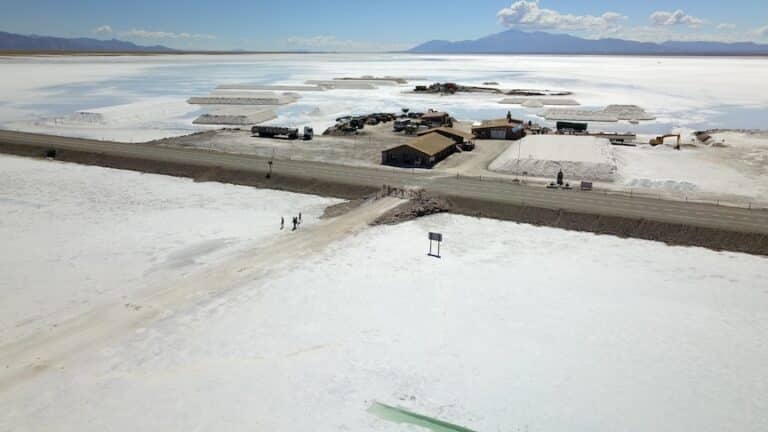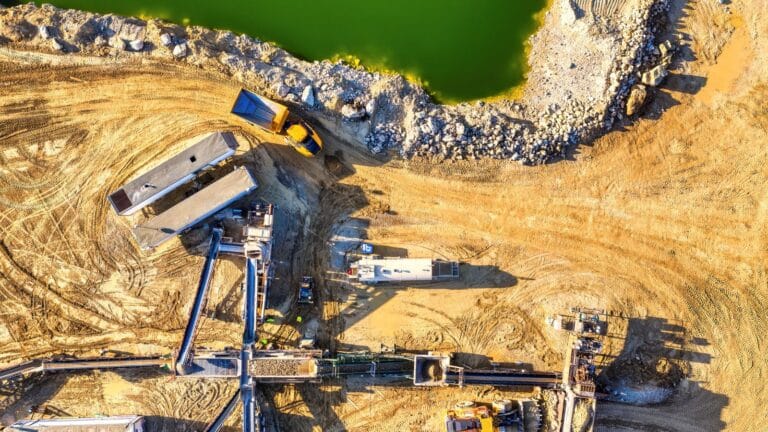This event summary reflects the authors’ understanding of key points made in the course of the discussion. It does not necessarily represent the views of the Center on Global Energy Policy. The summary may be subject to further revision.
Contributions to SIPA for the benefit of CGEP are general use gifts, which gives the Center discretion in how it allocates these funds. More information is available on our Partners page. Rare cases of sponsored projects are clearly indicated.
On September 21, 2023, the Center on Global Energy Policy at Columbia University SIPA convened a roundtable during Climate Week NYC to discuss challenges of expanding lithium supply for the energy transition. Stakeholders across the lithium supply chain—from mining companies to battery recycling companies—gathered to discuss, under Chatham House rule, its current state and barriers to growth.
Increased supply of lithium is paramount for the energy transition, as the future of transportation and energy storage relies on lithium-ion batteries. Lithium demand has tripled since 2017,[1] and could grow tenfold by 2050 under the International Energy Agency’s (IEA) Net Zero Emissions by 2050 Scenario.[2] Demand in the lithium market is growing by 250,000–300,000 tons of lithium carbonate equivalent (tLCE) per year, or about half of the total lithium supply in 2021.[3]
The lithium industry is evolving as demand increases, pricing mechanisms change, and geopolitical tensions create the need for new supply chains. The roundtable focused on nontechnical barriers to lithium supply, upstream technical innovation, and potential substitution of lithium with sodium, as well as opportunities for recycling lithium-ion batteries.
Nontechnical Barriers to Increased Lithium Production and Processing
Leading experts are estimating a lithium supply deficit by the 2030s, creating pressure to increase its production and processing today.[4] Long-term investments are needed for these capital-intensive projects. However, representatives from lithium mining companies said uncertainty in the market and geopolitical and domestic political tensions are barriers to increased production.
- China
According to event participants, China is a significant barrier to increased investment in global lithium processing outside of the country because of the control it has over the market through foreign investment in lithium mines and its majority share of lithium refining. Roundtable participants believe that China’s long-term vision is to maintain control of the supply chain and exert itself as a central player in the electric vehicle (EV) market. Participants said China’s lower capital and operating expenditures, and decade-long head start, has made it difficult for other countries to compete against it in mineral refining. Capital costs for new processing facilities in Australia can be 2.5 times larger than they are for facilities in China.[5]
Roundtable attendees also said China’s control of the market has allowed it to create price volatility for lithium chemicals needed for batteries—lithium carbonate and lithium hydroxide—by, for example, building up large inventories of cathodes and then selling them off. During periods when companies sell off cathodes, the part of the final battery that includes lithium, demand for lithium falls, forcing a parallel drop in prices. Participants noted that the sharp price drop, while artificial, signals to the wider market and potential investors weakness in the lithium market, lowering equity values for lithium companies. Additionally, long-term Chinese subsidies for EV adoption and direct subsidies to strategically important companies in battery supply, like CATL, have allowed China to influence the supply chain.[6]
- Policy Uncertainty
In Chile, the second-largest producer of lithium globally, policy uncertainty and regulation are limiting growth, according to event participants. They mentioned the Chilean government’s new lithium strategy, which seeks to expand into the more value-added segments of the lithium supply chain, by moving downstream, and make the industry more sustainable, such as through direct lithium extraction (DLE), discussed later in this summary. Despite the country’s move to boost state control over the lithium industry, the government announced it will respect existing contracts with leading lithium companies SQM and Albemarle until 2030 and 2043, respectively.[7] Still, event participants stated that they were not optimistic about growth in the sector because of political uncertainty and a lack of buy-in from communities for new mining projects. They thought uncertainty could limit Chile’s ability to attract investment or lead to China being the sole investor.[8]
Several attendees commented that the US Inflation Reduction Act (IRA) and financial incentives are important tools to increase lithium supply, but permitting issues and a lack of community support for lithium mining will have more impact on expanding production.
- Political Tension
Participants thought that both domestic politics and geopolitics are creating additional barriers for increased global lithium production. They said governments in resource-rich areas of Africa, Australia, Canada, and South America are trying to move downstream and localize lithium refining to capture more value-added segments and create local jobs. While this will add processing in the long term, participants noted that, combined with geopolitical tensions between the United States and China, it could add upward pressure on prices due to higher capital and operating expenditures.
Potential Policy Interventions
- Permitting Reform
Roundtable participants from the United States and South America agreed that permitting reform is necessary to expand lithium production. Permitting reform could give mining companies and others in the industry certainty that projects would begin production in a timely manner. Attendees said such reform would make projects more economically viable by reducing the years of litigation currently experienced before projects can create a reliable cash flow. They agreed that environmental and stakeholder review is vital and helps alleviate operating risk, but that the current permitting process is not working.
- Government Support
Participants argued that the United States and allied countries will need to continue to support mining and mineral processing facilities with financial incentives if those companies are to compete with China’s government support, technological know-how, and low capital and operating expenditures and expand the ex-China lithium supply chain. Mining and processing companies can take advantage of tax benefits in the IRA. Also, the Department of Energy has provided funding through the Bipartisan Infrastructure Law and the Department of Defense has funded projects through the Defense Production Act.[9]
Upstream Technical Innovation: Direct Lithium Extraction
Another topic discussed at the roundtable was mining companies’ development of innovative technologies to meet the growing demand for lithium. Direct lithium extraction (DLE), a catch-all term for projects that extract lithium from salt, geothermal, and oilfield brines while returning the water back underground, has gained significant media attention. The ultimate goal of DLE is to produce lithium from brines without need of evaporation ponds, to reduce environmental impacts and increase and accelerate production.
Roundtable participants stressed that the biggest challenge for DLE is that the technology is not one-size-fits-all, but instead must be tailored to each brine. While the technology is feasible, participants noted that companies must be able to scale the technology efficiently to be able to produce lithium in a cost-effective manner before it can impact lithium supply.
Discussants highlighted that increased government support would benefit DLE commercialization by supporting companies financially as they develop the new technology. The United States and Canadian governments have increased funding for DLE projects over the past year.[10] However, participants argued that large-scale commercialization will require additional funding.
Several participants mentioned that Arkansas has the potential to become a major DLE hub in the United States. Oil and gas companies, led by Exxon Mobil and Standard Lithium, an emerging lithium company, are investing in DLE projects in the state. Two event participants stated Arkansas will be a leader in DLE because the state is already a chemicals hub and home to several bromine projects. Additionally, they stated that oil companies will have a competitive advantage over junior miners because of their significant capital. Finally, they believe permitting issues will be less of a challenge in Arkansas compared to DLE projects in other states because of existing bromine projects.
Substituting Sodium for Lithium
Participants agreed that sodium-ion batteries have the potential to ease supply-side pressure on lithium by acting as a supplement for the supply chain. An expert from a sodium-ion battery startup said at the event that sodium-ion batteries, which trade sodium for lithium, are a “pressure release valve” for lithium. Unlike lithium and other battery metals, sodium is abundant globally, making it “cartel proof” and limiting geopolitical tensions in the supply chain. Sodium-ion battery vehicles have not taken off in the United States, despite the country producing over 90 percent of the world’s soda ash, the key component of the batteries.[11] Instead, China will soon hold 90 percent of the world’s sodium-ion battery manufacturing capacity.[12] Participants said one reason sodium-ion EVs have not been more popular in the US is because they have a lower energy density than their lithium counterparts, which equates to a smaller driving range per charge, making them less suitable for the US market, where drivers prefer bigger vehicles with extended ranges. Sodium is better suited to compact EVs in urban areas and battery energy storage systems.
Looking to the future, the sodium-ion expert stated that sodium-ion cathodes can be produced on production lines designed for nickel-manganese-cobalt lithium-ion batteries (NMC). As lithium-iron-phosphate lithium-ion batteries (LFP) increase in popularity, sodium could be produced on brownfield NMC cathode sites, limiting capital expenditures.
Recycling Lithium-Ion Batteries
Event participants agreed that lithium-ion battery mineral recycling has the potential to ease demand, but that battery recyclers need to commercially scale quickly and government partnerships are necessary to prevent losing the valuable battery materials to other markets. The IEA estimates recycling could reduce mineral demand by 10 percent by 2040, but increased mining is still necessary.[13] Similar to their lead in processing and EV uptake, China is the leading recycler because of government policies implemented over the past decade. The first recycling policy was enacted in 2012, followed by subsequent policies.[14]
A roundtable participant associated with American recycling said recycling companies are preparing for a “tsunami of end-of-life batteries” in the 2030s, as EV batteries reach their end of life. They said scrap from battery manufacturing and automakers is currently the main feedstock. The United States is third behind Europe for current and planned capacity of recycling.[15]
Despite the potential, participants stressed that there are significant constraints on battery recycling that will require innovation and partnerships to overcome. The largest issue is the potential leakage of battery materials; in other words, the average vehicle owner will sell their vehicle before the battery is ready for recycling, and the vehicle could leave the US during its second and third life, out of the reach of American recyclers. According to a representative from a battery recycler at the event, keeping the feedstock in the United States will be critical for the growth of domestic recycling, as the Asian recycling market is more mature with lower costs and environmental standards. Participants said the private sector and governments will need to partner on regulations to prevent leakage and allow the nascent North American market to grow. They stated that the only regulation related to recycling in the United States was enacted by California.[16]
Finally, an expert from a battery recycling company stated that lithium-ion battery recycling is currently only economically feasible for nickel-based lithium-ion batteries like NMC and nickel-aluminum-cobalt battery chemistries in the United States. Companies will need to develop the technology to recycle LFP batteries, especially as the share of LFP vehicles increases.
Conclusion
The Inflation Reduction Act and BIL have spurred new lithium investment, however participants agreed additional investment and government policies are necessary to increase the supply of lithium to meet the demand for the energy transition. Attendees also said that if the United States and allies want to create a secure ex-China supply chain, additional government support is necessary: non-Chinese companies are competing against Chinese companies that benefit from a decade of substantial government support. Participants noted that permitting reform and battery recycling policies are necessary to localize lithium mining and processing.
Notes
[1] International Energy Agency, “Critical Minerals Market Sees Unprecedented Growth as Clean Energy Demand Drives Strong Increase in Investment,” July 11, 2023, https://www.iea.org/news/critical-minerals-market-sees-unprecedented-growth-as-clean-energy-demand-drives-strong-increase-in-investment.
[2] International Energy Agency, “Critical Minerals Data Explorer,” accessed December 8, 2023, https://www.iea.org/data-and-statistics/data-tools/critical-minerals-data-explorer.
[3] Andy Home, “Lithium Still Super-Charged as Supply Chases after Demand,” Reuters, December 15, 2022, https://www.reuters.com/markets/commodities/lithium-still-super-charged-supply-chases-after-demand-2022-12-15/.
[4] Simon Moores, “Opinion: Albemarle’s Turbo-Charged Demand Data Showcases Lithium’s Growing Supply Problem,” Benchmark Mineral Intelligence, January 26, 2023, https://source.benchmarkminerals.com/article/opinion-albemarles-turbo-charged-demand-data-showcases-lithiums-growing-supply-problem.
[5] Natasha Frost, “Australia Tries to Break Its Dependence on China for Lithium Mining,” New York Times, May 23, 2023, https://www.nytimes.com/2023/05/23/business/australia-lithium-refining.html.
[6] Kenji Kawase, “China Gives EV Sector Billions of Yuan in Subsidies,” Nikkei Asia, September 21, 2023, https://asia.nikkei.com/Spotlight/Electric-cars-in-China/China-gives-EV-sector-billions-of-yuan-in-subsidies.
[7] Alexander Villegas and Ernest Scheyder, “Chile Bid to Boost State Control over Lithium Spooks Investors,” Reuters, April 21, 2023, https://www.reuters.com/markets/commodities/sqm-albemarle-shares-slide-chile-lithium-nationalization-plan-2023-04-21/.
[8] China’s Tsingshan Holding Group recently announced it will invest $230 million in Chile to develop an LFP cathode manufacturing facility and will receive a “preferential price” of over 11,000 tLCE in return. James Attwood, “China’s Lithium-Triangle Inroads Show US Challenges in EV Race,” Bloomberg, October 16, 2023, https://www.bloomberg.com/news/articles/2023-10-16/china-s-tsingshan-gets-access-to-chilean-lithium-in-battery-metal-race.
[9] The US Department of Energy is providing Albemarle $149 million for a lithium processing plant and Piedmont Lithium $141 million for a lithium hydroxide plant through funding in the Bipartisan Infrastructure Law. Albemarle has also received a $90 million grant through the Defense Production Act for their Kings Mountain, North Carolina, lithium mine. Finally, Ioneer received a $700 million loan from the Department of Energy’s Loan Programs Office for the Rhyolite Ridge lithium project. The loan will be for the processing facility at the location because the Loan Programs Office cannot legally finance mining projects. US Department of Energy, “Bipartisan Infrastructure Law Battery Materials Processing and Battery Manufacturing & Recycling Funding Opportunity Announcement,” October 2022, https://www.energy.gov/sites/default/files/2022-10/DOE%20BIL%20Battery%20FOA-2678%20Selectee%20Fact%20Sheets%20-%201_2.pdf; US Department of Defense, “DoD Enters Agreement to Expand Domestic Lithium Mining for U.S. Battery Supply Chains,” press release, September 12, 2023,
https://www.defense.gov/News/Releases/Release/Article/3522657/dod-enters-agreement-to-expand-domestic-lithium-mining-for-us-battery-supply-ch/; US Department of Energy, Loan Programs Office, “LPO Announces Conditional Commitment to Ioneer Rhyolite Ridge to Advance Domestic Production of Lithium and Boron, Boost U.S. Battery Supply Chain,” January 13, 2023, https://www.energy.gov/lpo/articles/lpo-announces-conditional-commitment-ioneer-rhyolite-ridge-advance-domestic-production.
[10] For instance, through the Bipartisan Infrastructure Law, the US Department of Energy (DOE) awarded Lilac Solutions a $50 million grant in October 2022. US Department of Energy, “Bipartisan Infrastructure Law Battery Materials Processing and Battery Manufacturing & Recycling Funding Opportunity Announcement.” In March, E3 Lithium received CA $3.5 million through Natural Resources Canada’s Critical Minerals Research Development and Demonstration program. E3 Lithium Ltd., “E3 Lithium Awarded $3.5M in Funding from Government of Canada,” press release, March 7, 2023, https://www.newswire.ca/news-releases/e3-lithium-awarded-3-5m-in-funding-from-government-of-canada-846381288.html. In July, the DOE awarded $10.9 million for ten projects related to direct lithium extraction from geothermal brines. Energyx was the largest recipient, with a grant totaling $5 million. US Department of Energy, “Funding Selections: FY22 AMMTO-GTO Lithium Extraction and Conversion from Geothermal Brines,” https://www.energy.gov/eere/ammto/funding-selections-fy22-ammto-gto-lithium-extraction-and-conversion-geothermal-brines.
[11] US Geological Survey, “Mineral Commodity Summaries 2020,” January 2020, https://pubs.usgs.gov/periodicals/mcs2020/mcs2020.pdf.
[12] Keith Bradsher, “Why China Could Dominate the Next Big Advance in Batteries,” New York Times, April 12, 2023, https://www.nytimes.com/2023/04/12/business/china-sodium-batteries.html.
[13] China leads in lithium-ion battery recycling with an estimated capacity of 230 kt per year, in addition to the most planned capacity. International Energy Agency, “The Role of Critical World Energy Outlook Special Report Minerals in Clean Energy Transitions,” May 2021, https://iea.blob.core.windows.net/assets/ffd2a83b-8c30-4e9d-980a-52b6d9a86fdc/TheRoleofCriticalMineralsinCleanEnergyTransitions.pdf.
[14] California Environmental Protection Agency, “Lithium-Ion Car Battery Recycling Advisory Group Draft Report,” March 11, 2022, https://calepa.ca.gov/wp-content/uploads/sites/6/2022/03/AB-2832-Final-Draft-Policy-Recommendations-Lithium-ion-Car-Battery-Recycling-Advisory-Group-As-of-3-11-22.a.hp_.pdf
[15]International Energy Agency, “Critical Minerals Market Review 2023,” July 2023, https://iea.blob.core.windows.net/assets/afc35261-41b2-47d4-86d6-d5d77fc259be/CriticalMineralsMarketReview2023.pdf.
[16]California passed the Responsible Battery Act of 2022. By 2027, producers of batteries sold in California will be required to create or fund a program to collect and recycle their batteries. But the regulation only applies to batteries sold in-state. Russ LaMotte and Jeff Clare, “California Passes Two New Laws to Overhaul State’s Battery Extended Producer Responsibility Program and Broadly Expand State’s E-Waste Program,” Beveridge & Diamond, October 6, 2022, https://www.bdlaw.com/publications/california-passes-two-new-laws-to-overhaul-states-battery-extended-producer-responsibility-program-and-broadly-expand-states-e-waste-program/.






